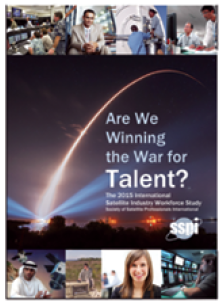"Our people,” says the CEO, “are our most important assets.”
“Yeah, right,” mumble the Important Assets.

If this sounds familiar to you, then you understand the difference between “talking the talk” and “walking the talk” when it comes to managing talent. In point of fact, people ultimately are the most important asset of the company. A motivated, skilled, painstaking and creative team with sufficient resources will almost always outplay a resource-heavy team whose heart is not in the game.
In SSPI’s recent workforce study, Are We Winning the Talent War?, we found some great practices in recruiting and nurturing talented people. But we also found that only a minority of companies in the satellite industry is actually implementing them today. One goal of our workforce research is to spread the wisdom farther and get more companies adopting the best practices of the savvy leaders.
Talent Attraction
The larger companies in the space already have significant talent attraction programs that are focused on youth. “We have a successful internship program,” one HR leader told us, “and we are working to enhance it with job-shadowing opportunities and more advanced co-op programs that let students combine school and work.”
“We have an associates program,” an executive at a peer company reported. “We hire younger folks in their 20’s who have recently earned a masters degree. They have some work experience and we put them into a work-study rotation that leads to the opportunity to hire them after
two years.”
Another leader has established links with four different universities and technical schools and has established internships ranging from 30 to 40 days to 90 day engagements. “Internships are a good way to identify potential employees, and we often hire interns once they have completed their studies.”
One company shared specifics about the intensive approach they take to internships. “We ask business group managers to submit requisitions for interns with specific skill sets to accomplish specific missions,” said the firm’s HR leader. “From those requests, we recruit 35 interns per year from universities and our hiring managers target the ones who do best for
full-time employment.”
When you get past the largest companies in the industry, however, there is a much less of a consistent and structured approach to recruiting the next generation. A remarkable 56 percent of human resource executives reported that their companies have no formal internship or work
study program.
What some of them have instead is an informal effort, typically led by a self-appointed individual with a passion for mentoring young people. “We bring in five interns on a paid basis for a couple of months over the summer and train them,” said one executive. Another noted that even this small effort is productive. “We have hired two people who interned for us over the summer in their third year of college.”
Companies may consult on curriculum with local universities. They may fund scholar-ships or invite individual students to intern. When the self-appointed leader leaves or retires, however, the effort typically falls apart because it has not been institutionalized within the organization. This is a gap that clearly must be filled if the whole industry is to maintain its
competitive edge.
On-Boarding
While fewer than 60 percent of respondent companies have formal internship or work-study programs, 70 percent have formalized their on-the-job training for new hires. Once we have found the right people,” explained an executive, “we have a structured training program with different modules for different roles. It takes six months to one year to produce a fully-trained technical account manager in the systems engineering team. Salespeople also need to have a strong technical understanding, which takes training.”
Another company outlined its intensive training program for new hires, which includes lecture sessions, formal tests and internal certification and can last as long as 12 months before an employee is considered fully trained, particularly for a sales engineering position. The program has been developed organically over several years, but the company is only now considering the hiring of a full-time training manager.
Filling the skill gaps is high on the agenda for the companies. “Universities don’t tend to have the courses that would provide us with qualified prospective recruits,” said one executive. “We have to teach graduates the video aspects of the job.” For another, “the key issue is telecoms training. Our activities require a mix of strong software programming skills and sound knowledge of telecoms. The latter is lacking in most new graduates and we have to provide the training.”
Continuing Education
The training that starts in the onboarding process continues, at many companies, throughout a career. One respondent to our study described the company’s Talent Center: programs lasting two to three days that include teaching, practice and assessment. This is followed after one to two years by individual coaching to help employees prepare for a particular career path in the company. “The message is that you are important to our future,” she noted, “and we want your future to be here.”
One European company says it offers 70,000 hours per year of training across technical, process, compliance and management topics. Another offers internal certification programs for disciplines including operations, sales, management and dealing with customers.
One of the industry’s larger players offers comprehensive training and certification programs for its employees—but has supplemented them by signing on to massively open online coursework (MOOC) from a major university and making it available to employees at no cost.
Another of the largest companies in the business operates its own university within the organization to deliver training in technology, sales, leadership and customer engagement. In addition, the company provides a Stretch program, in which teams from different areas are formed to address a specific technology or business challenge over a limited period of time. “It gives members of the team visibility across the organization,” the HR leader noted, “as well as addressing problems that otherwise would be ignored.”

Mentoring
Mentoring has been part of career development since people first figured out that they had to work for a living. Younger and less experienced employees learn from their older and more experienced colleagues. The learning in a mentoring relationship is not just about knowledge transfer: learning also concerns attitude, expectations and judgment and is about engaging the loyalty of younger employees and encouraging commitment to the organization’s mission.
Mentoring takes place regardless of whether companies encourage such to occur. Of the HR executives interviewed in the study, 57 percent work for companies where mentoring remains an informal undertaking by people who understand the value of such work. But at 43 percent of the firms, mentoring is taken more seriously as a factor in business success.
At most of them, mentoring begins in the onboarding process. Several executives say their companies simply assign an experienced employee to help each new hire get up to speed on everything from business cards and email to where to eat lunch.
At 20 percent of the companies interviewed, however, mentoring is taken a step further. In one, mentors and mentees fill out applications and are matched by the human resources department. They work together over a yearlong program with specific goals, and assess their progress jointly with HR at the end.
The program at another company involves 100 people per year, with a 50/50 split between mentors and mentees. “We select high-potential employees globally and provide them with training on how to optimize relationships. They and their mentors have a set of goals and meet once or twice a month to carry them out.”

Design an Earth station or satellite, put it into operation, and performance will generally continue with minimal maintenance. However, the really important assets of your business, the ones that go home at the end of every day, need considerably more upkeep. The good news is that the rewards for attracting and nurturing the best talent are huge.
Robert Bell is the executive director of the Society of Satellite Professionals International (www.sspi.org) and author of Are We Winning the Talent War? Robert can be reached at rbell@sspi.org. The report may be downloaded at no charge by SSPI members and sponsors, and purchased by non-members at www.satelliteworkforce.com.


